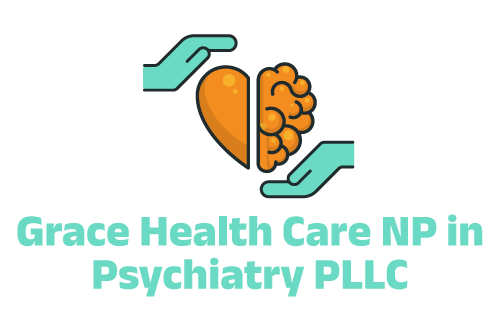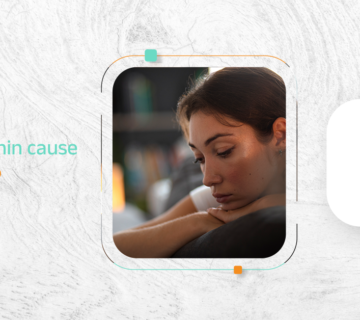Bipolar disorder or PTSD could be behind extreme emotional shifts. It’s vital to recognize this. Mild changes are normal, but drastic ones need attention.
Identifying these patterns is crucial for spotting mental health issues. A correct diagnosis improves treatment.
We’ll explore mood swings with PTSD or bipolar disorder. We’ll look at their traits, differences, and daily life impact.
Dealing with PTSD or bipolar disorder mood swings?
Grace Healthcare NP in Psychiatry PLLC is ready to assist. We offer medication, therapy, and healthy living tips. Contact us for details.
What Are Mood Swings?
Let’s define mood swings before exploring mood swings with PTSD or bipolar disorder.
Mood swings are quick shifts in emotions. They move from euphoria to deep sadness or anger.
Mood swings cause temporary mood changes. These can include:
- Nervousness
- Anxiety
- Irritability
- Frustration
- Sadness
- Excitement
Bipolar moods change daily. One minute you’re happy, the next, very sad. Memories of past trauma could trigger these.
Mood Swings vs. Bipolar Disorder
Bipolar disorder relates to the brain. It causes drastic mood swings. Bipolar disorder isn’t responsible for all mood changes. They vary in their emotional shifts’ strength and length. The difference between mood swings and bipolar disorder, you need to identify the mood transformations’ patterns and harshness. Just mood swings may not suggest bipolar disorder. Key differences include:
- Frequency: Bipolar disorder features frequent, severe mood changes. Simple mood swings may be less consistent and less intense.
- Impact: Bipolar disorder significantly affects daily life. Mood swings may be less disruptive.
Bipolar mood swings can stick around for days or weeks. Those dealing with bipolar disorder mood swings may experience:
- Extreme highs (mania or hypomania)
- Extreme lows (depression)
These mood changes are not just fluctuations but intense enough to disrupt daily life. For example:
Manic episodes bring extreme happiness and energy. Depression brings despair and exhaustion.
Can PTSD Cause Bipolar Disorder?
PTSD and bipolar disorder are two different mental issues. But they can appear together or affect each other.
PTSD normally happens after a scary event. It triggers bad memories and anxiety. Both conditions involve mood swings, but they’re not the same. The tension from PTSD could intensify mood issues or cause new ones.
Both problems show signs like short-temperedness and mood instability. This overlap can make diagnosis and treatment tricky.
If you see symptoms of either disorder, seek help. It’s vital for proper evaluation and treatment.
PTSD and Mood Swings
Is PTSD a mood disorder? PTSD isn’t about moods, but it’s a type of worry appearing after scary events. This can bring scary dreams, anxiety, and ongoing thoughts.
Mood issues like depression and bipolar disorder mainly change feelings. Even though PTSD can affect mood and show similar signs, it focuses on trauma and anxiety.
This categorizes it as an anxiety disorder. PTSD induces mood changes stemming from trauma, differing from the steady states seen in bipolar disorder.
These shifts are brief and linked to specific triggers. For example, a reminder of trauma can lead to an emotional outburst.
However, the mood stabilizes once the trigger is gone. Unlike bipolar disorder, which has long episodes, PTSD mood swings are brief. They are linked to cues that trigger painful memories.
Bipolar Disorder vs PTSD
Bipolar disorder and PTSD differ in crucial ways:
- Duration and Consistency: Bipolar disorder has mood episodes lasting for days or weeks. PTSD mood swings are shorter and event-triggered.
- Triggers: PTSD mood swings are triggered by trauma reminders. In contrast, bipolar disorder mood changes occur without clear triggers.
- Mood Patterns: Bipolar disorder has definite periods of high and low mood. PTSD, instead, has moods that sway unpredictably and are tied to stress.
Bipolar Mood Swings vs. Hormonal Mood Swings
People can confuse bipolar mood swings with hormonal ones. Things like periods or menopause can make moods swing similar to bipolar disorder. Yet, mood swings from bipolar disorder are usually more sharp and last longer than mood changes from hormones.
How Can Mood Swings with PTSD or Bipolar Disorder Impact Daily Life?
PTSD and Bipolar Disorder can cause mood swings. They can significantly affect daily life. Here’s how:
-
Professional Impact
Mood swings can hurt productivity. They make it hard to finish tasks, meet deadlines, or stay focused, lowering job performance. Mood changes also affect work relationships. Colleagues may struggle with an unpredictable person, which can cause misunderstandings or conflicts.
-
Social Life
People might avoid socializing or relationships due to embarrassment or low energy. Conversely, they might act impulsively or take risks when feeling good. These mood swings can strain relationships. Partners, family, or friends may struggle with these rapid changes. This can cause conflicts or lead to them pulling away.
-
Emotional Well-being
Intense mood swings can increase stress and anxiety. Constant emotional changes harm well-being and make daily stress more challenging. They also impact self-esteem. People might feel out of control, leading to feelings of inadequacy or doubt.
-
Daily Functioning
Mood swings can disrupt daily life. They disrupt sleep, eating, and household routines. In manic episodes, they act impulsively. In depressive episodes, they find decision-making hard. This affects choices about money and planning activities.
-
Health Implications
Headaches and stomach problems often stem from mood swings and stress. These can weaken your immune system. So, managing stress is vital for mental and physical health. Mood changes might cause you to skip medication, making treatment less effective.
-
Safety Concerns
During manic episodes, people might take more risks. They might abuse substances or engage in dangerous activities. Conversely, in severe depressive phases, the risk of self-harm or suicidal thoughts increases.
Managing Mood Swings
Managing mood swings from PTSD or bipolar disorder requires several strategies:
-
Therapy
Talk therapy like (CBT) and other psychotherapies effectively manage symptoms. They provide valuable tools for control.
-
Medication
Bipolar disorder needs treatment using mood stabilizers or antipsychotics. PTSD is treated with medicine that aids with worry and sadness. Both illnesses can be helped greatly with tailored medicines.
-
Lifestyle Changes
Exercising, eating right, and getting enough sleep helps control emotions. These habits support a balanced mind.
-
Support Systems
A network of supportive friends and family can provide emotional stability.
Conclusion
It’s crucial to grasp the mood swings with PTSD or bipolar disorder for the needed assistance. Bipolar disorder prompts weeks of roller-coaster emotions.
Sudden shifts in PTSD, caused by trauma, are common. Both mess with feelings, but their triggers and timings vary. Comprehending these variations aids in finding optimal care.
The solutions range from therapy, medicine, and lifestyle tweaks, to help from dear ones. Mood fluctuations from PTSD or bipolar disorder are manageable.
Understanding their roots promotes a better daily existence.
FAQs
Q: Can trauma cause bipolar in adults?
Trauma can trigger symptoms in those predisposed to bipolar disorder. But, it doesn’t directly cause it.
Q: What marks manic depressive mood swings?
Signs include high energy and mood, followed by deep depression.
Q: Can PTSD look like bipolar disorder?
Yes, PTSD may seem like bipolar disorder. They both result in mood shifts and emotional fluctuations.







No comment